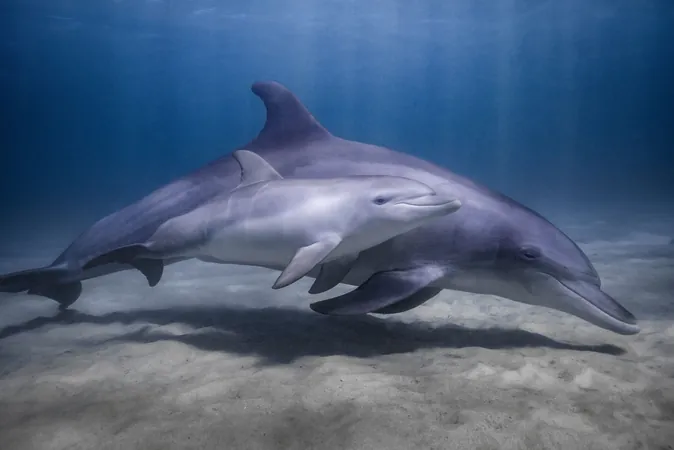
Breakthrough in Dolphin Communication: Meet the AI That Understands Their Accents!
2025-01-09
Author: Yu
Introduction
With an astonishing 42 species of dolphins utilizing hundreds of distinct sounds, communicating can resemble a chaotic orchestra. To complicate matters further, each species of dolphin exhibits regional 'accents', prompting researchers to turn to cutting-edge technology for clarity.
Development of ROCCA
At the forefront of this innovation is Dr. Julie Oswald and her team at the University of St Andrews Scottish Oceans Institute. They have developed an advanced machine learning tool that not only identifies different species based on their unique calls but also takes into account these fascinating regional variations.
What is ROCCA?
This groundbreaking technology, aptly named the Real-time Odontocete Call Classification Algorithm (ROCCA), categorizes dolphin calls by species, while acknowledging diverse geographical accents. Imagine being able to distinguish a North Sea bottlenose dolphin from its Pacific counterpart with just the click of a button!
Dolphin Communication
The underwater realm is notoriously noisy, with dolphins producing a significant portion of that soundscape. Interestingly, dolphins are known to develop ‘signature whistles’—distinctive sounds that serve as a form of identification throughout their lives. This ability to mimic sounds from their environment is crucial during their development, especially in learning to communicate with their pod.
Challenges in Research
Traditionally, scientists have used hydrophones—underwater microphones—to capture and analyze dolphin sounds. However, linking these sounds to specific species has been a challenging endeavor. Dr. Oswald shares, “While visual observation and hydrophones provide valuable data, matching these sounds to the correct dolphin species has been a significant hurdle.”
Impact of ROCCA
Thanks to ROCCA, researchers can now decode the intricate nuances in dolphin vocalizations. The algorithm’s genius lies in its capacity to recognize the regional accents among species, enhancing conservationists’ abilities to track populations and evaluate the repercussions of human activities, such as fishing and underwater sonar disturbances.
Expanding Applications
But the success of ROCCA does not stop with dolphins. Dr. Oswald is already extending its applications to other marine species across diverse ecosystems in West Africa, Macaronesia, and the Mediterranean, training scientists and conservationists in acoustic monitoring methods.
Recognition and Awards
In a remarkable recognition of this innovation, ROCCA was awarded one of the two prestigious Earth Rangers 2024 Conservation Technology Awards earlier this month, celebrating technologies that have a tangible impact on conservation efforts. The awards program has distributed an impressive $120,000 in funding to global conservation initiatives since its inception.
Future Plans
Jes Lefcourt, a senior director of conservation technology, hailed the Institute's contribution, stating, “The Scottish Oceans Institute has dedicated two decades to enhancing the understanding of cetacean communication. Their pioneering work using AI is not only advancing population monitoring but is also illuminating the unique characteristics of these remarkable animals.”
Delighted with the award, Dr. Oswald plans to utilize the £15,000 prize money to develop new classifiers, bolster data collection, and train more users to effectively implement ROCCA.
Conclusion
As we continue to explore the depths of our oceans, advancements like ROCCA represent a significant leap towards understanding and conserving marine life. Stay tuned, as this evolving technology promises to unveil the mysteries of dolphin communication and beyond!

 Brasil (PT)
Brasil (PT)
 Canada (EN)
Canada (EN)
 Chile (ES)
Chile (ES)
 Česko (CS)
Česko (CS)
 대한민국 (KO)
대한민국 (KO)
 España (ES)
España (ES)
 France (FR)
France (FR)
 Hong Kong (EN)
Hong Kong (EN)
 Italia (IT)
Italia (IT)
 日本 (JA)
日本 (JA)
 Magyarország (HU)
Magyarország (HU)
 Norge (NO)
Norge (NO)
 Polska (PL)
Polska (PL)
 Schweiz (DE)
Schweiz (DE)
 Singapore (EN)
Singapore (EN)
 Sverige (SV)
Sverige (SV)
 Suomi (FI)
Suomi (FI)
 Türkiye (TR)
Türkiye (TR)
 الإمارات العربية المتحدة (AR)
الإمارات العربية المتحدة (AR)